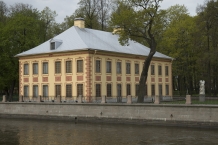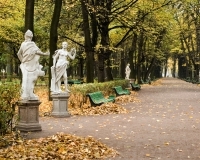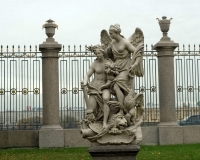Summer Palace of Peter I and Summer Garden
Laid out in 1704, the Summer Garden is just one year younger than St. Petersburg. The park was conceived by Peter I who chose a site on the left bank of the Neva River and prepared the first design. The garden was bounded by the Neva River on the north, the Fontanka River on the east, the Lebyazhy Canal on the west and a canal connecting the Fontanka and the source of the Moika River on the south. The garden was designed in a regular arrangement following the model of European gardens and featured flower beds, green mazes, a kitchen garden for growing medicinal plants and vegetables, gazebos and fountains. At different times, the creation of the garden was contributed by both Russian and foreign architects and gardeners, such as Ivan Matveev, Domenico Trezzini, Jean-Baptiste Le Blond, Mikhail Zemtsov, Francesco Bartolomeo Rastrelli, Jan Rosen, Ivan Surmin and Cornelius Schrader. In 1713–1725, architect Andreas Schlüter built the Grotto Pavilion facing the Fontanka River and the Karpiev pond was dug out in the garden at the same time.
A fountain system began to be created as the garden was laid out. Initially, a water-lifting mechanism to supply water to the fountains was driven by horses. In 1718, it was replaced with a steam water-lifting machine. The water was taken from the river which has since been named “Fontanka”. The Poperechny Canal running from the Lebyazhy Canal to the Fontanka River was dug the following year. It divided the garden into two nearly equal parts. The bosquets — areas surrounded by trellis walls — accommodated different “park amusements”, such as the Birdyard with a dovecote and the Menagerie Pond with an island featuring a gazebo in the center. The French Parterre bosquet decorated with gilded sculptures, a cascade and a flower bed looked particularly elegant. Fountains were playing at the intersection of the central and side alleys.
By order of Peter I, marble sculptures to decorate the Summer Garden were delivered from Italy. The procurement was managed by close confidants of Peter I. Busts of the Polish King Jan Sobieski and his wife Queen Marie Casimire were among the first installed in the Summer Garden. In 1710, the garden had about thirty statues and busts, and by the year 1728, their number reached more than one hundred. An antique statue of Venice by an unknown Italian sculptor dated from the 2nd or 3rd century BC based on the original Greek statue was erected in the Summer Garden in 1720. It was found by excavations in Italy in 1719 and given as a present to Peter I by Pope Clement XI. The perfectly executed statue was one of the main attractions in the garden. Now it is part of the collection of the State Hermitage Museum.
The Allegory of the Nystad Peace Treaty sculptural group made by Italian sculptor Pietro Baratta to special order was brought to St. Petersburg and installed in the Summer Garden in 1726, after Peter’s death. The monument represents an allegory of the Nystad Peace Treaty of 1721 which put end to the more than 20-year-long war between Russia and Sweden. The compositional and conceptual pivot of the group is a sitting female figure holding a cornucopia and an upturned burning torch, who represents Russia. Another female figure, representing Victory, has her wings spread wide over the sitting woman. She is trampling on a lion which represents defeated Sweden.
The sculptural decorations in the Summer Garden were supplemented with numerous statues, mainly of gilded lead, which decorated the fountains.
In the Petrine era, the Summer Garden was a venue for assemblies and balls. It was here that festivals, illuminations and firework displays took place to celebrate victories of Russia in the Northern War.
In 1710-1713, when the Summer Garden underwent landscaping, the construction of a stone building to the design of Domenico Trezzini began on the site of a former Swedish farmstead, where Peter previously stayed in its main house. It is a two-storey brick building with a hipped iron roof. The entrance to the palace is framed in a black marble portal with a bas-relief above it depicting Minerva with spoils of war. The façades are decorated with 28 framed bas-reliefs completed using the rare technique of manual plastering. These are located between the windows of the first and second floors. The allegorical bas-reliefs are believed to have been made by the German architect Andreas Schlüter. The roof of the palace is topped with a weather vane depicting St. George the Victorious hitting a snake with a spear. The weather vane was driven by a mechanism of a wind device located inside the building, which showed the direction and strength of the wind on a dedicated panel. The device was ordered by Peter I from a court mechanic in Dresden. A system set up in the palace was the first one in St. Petersburg. Initially, the Summer Palace was surrounded by water on three sides: by the Never River coming near its front on the north, by the Fontanka River running on the east, and by a small harbor in front of the entrance on the south. Boats and yawls approached the palace on the Neva and were moored near the façades.
Like with any dwelling preferred by Peter I, his palace is not large. Both floors have the same layout. Peter I’s private rooms were on the first floor, his wife Ekaterina Alekseevna and children lived on the second floor. Designed as a summer residence, the Palace had thin walls and single window frames. In total, the palace has 14 rooms, including a reception hall, an office, a turnery, a dressing room, a bedroom, a large hall for assemblies, two kitchen rooms, and two interior corridors. The rooms are arranged in enfilade.
Next to the palace, there was the so-called “Servants’ Quarters” — a two-storey stone building with the shapes resembling the palace. It housed a library and numerous collections made by the Tsar, including the anatomical collection of Dutch researcher Frederik Ruysch. Both the library and the collections were moved to the Kikiny Chambers while Peter was alive, and later transferred to the Kunstkammer. Subsequently, the collection of books by Peter I was given to the Academic Library.
A large room on the first floor of the Servants’ Quarters housed the Amber Room presented to Peter by the King of Prussia in 1717. After Peter’s death, the Amber Room was installed in the Winter Palace and later moved to Tsarskoye Selo. (The Amber Room disappeared during the Second World War, but its replica was constructed and currently can be viewed in the Catherine Palace in Tsarskoye Selo.)
A single-storey stone gallery which connected the Servants’ Quarters with the Palace had living rooms with glazed tile stoves. In the summertime, they were occupied by the children of Tsarevich Alexei Petrovich Peter (the future Emperor Peter II) and Natalia. There were separate rooms for shooters, guard soldiers, sailors, a clockmaker, a tailor and a carpenter.
After the death of Peter I, the Summer Palace was not used for living for a long period of time. At one point, it was used to hold meetings of the Supreme Privy Council.
The high days of the Summer Garden were under the reign of Elizabeth, when the trees had grown and become strong, and the fountains worked properly. Flower beds of complex geometric patterns were arranged to the design of Rastrelli. The Empress allowed the wider public to the Summer Garden.
By the end of the 18th century, the garden had a drastically changed appearance, as the flood of 1777 had severely damaged the composition at the main entrance and destroyed the fountains.
In 1784, a railing designed by architect Yuri Felten in cooperation with Pyotr Yegorov was installed on the side facing the Neva River near the Summer Palace. This is a masterpiece of Russian classicism which has become one of the symbols of St. Petersburg. It consists of 36 granite columns topped with vases and urns and a forged iron railing with decorations in gilded bronze. In 1799, a stone terrace was built on the Lebyazhy Canal where cast iron tripod vases (by architect Ludwig Charlemagne) were installed in 1825. In 1825-1826, a cast iron railing decorated with fittings and shields with the head of Medusa (by architect Charlemagne after the original created by Pierre-Dominique Bazaine) was built along the southern border of the garden.
In the 19th century, the Summer Garden was opened to public and turned into a landscape park. In 1826, Carlo Rossi rebuilt the Grotto Pavilion into the Coffee House, and a year later, the wooden Tea House was built to the design of Ludwig Charlemagne. A porphyritic vase presented by the King of Sweden and Norway Charles XIV was set between the southern fence and the pond in 1839. A bronze monument to fabulist Ivan Krylov by sculptor Peter Clodt was installed in one of the bosquets in 1856. He is represented seated on a stone, dressed in a loose coat and holding an open book in his hands. The dark gray granite pedestal is decorated with high-reliefs with scenes from Krylov’s fables made by Peter Clodt.
A granite chapel to commemorate the rescue of Alexander II was incorporated into the Neva Railing on the site where Dmitry Karakozov committed an assassination attempt on the Emperor (the chapel was dismantled in 1930).
In the early 19th century, the Summer Palace was rented as summer homes to high officials. Its history as a museum dates to 1903, when an exhibition dedicated to Peter I was opened there as part of the celebrations of the 200th anniversary of St. Petersburg.
After the 1917 Revolution, the Summer Garden was declared public domain and placed under government protection. A memorial historical household museum was opened in the Summer Palace in 1934.
In 2004, the Summer Garden and the Summer Palace became part of the State Russian Museum. In 2009, the garden was closed for reconstruction which continued for four years and involved making copies of the sculptures and pedestals from artificial marble to replace the original pieces, restoring the cast iron fence on the Moika embankment, and recreating the central gates of the Neva Railing, the Small Greenhouse and the Dovecote pavilions, and eight fountains. Dried-up trees were cut down, diseased trees healed, and new trees and shrubs planted.
The original marble sculptures from the Summer Garden were restored and are currently kept in the halls of the St. Michael’s (Engineers’) Castle, which is also part of the Russian Museum.






